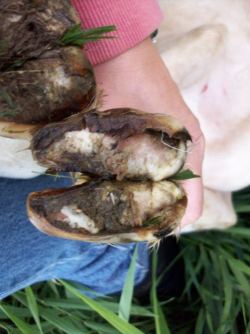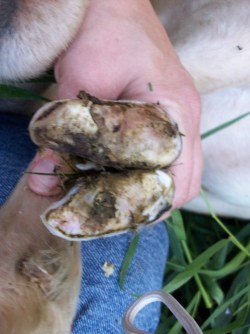I am seriously considering purchasing some software to manage my sheep flock’s breeding program. Though I only have six ewes, I’m thinking of buying more, and possibly unregistered ones that I would use in a grade-up program with the purebred ram.
And, I’ve realized that these Katahdin pedigrees are very hard to read– all numbers. They charge $100 extra if you want to assign a name to a “special” animal; which obviously discourages naming.
I have a pet peeve with any animal registry that doesn’t encourage easy-to-read, unique naming conventions. Though AKC dogs, race horses and the like can often have silly, superfluous names, it does allow for easy pedigree reading. You can always remember something like “that animal is out of Howdy Rowdy and Mrs. Slick.” MUCH easier to read and recall than “by 15064 out of 33870.” I can’t stand the Border Collie world’s convention of single-syllable dog names either, my head swims with trying to differentiate Jane Doe’s “Moss” from Billy Jones’ “Moss”. There can be a dozen different dogs all named Moss in the same pedigree! 🙁
So, back to my software choices, I’ve been searching the web for what options are out there. I respect software developers who know how to do Search Engine Optimization (SEO) to market their product, and am highly suspicious of software developed by anybody who cannot get their product on the first page of a google search. I’ve decided, too, that I don’t want to spend more than about $100 for the software, and preferably a lot less. I do like the idea of Palm Pilot extensions, because I’m already taking notes on my Palm phone when out in the field. So, here is what I found that is under consideration.
High relevancy in google searches:
FlockFiler is $50. I find their website to be a little cluttered and weird. I did read some good reviews on it on a discussion list. Free demo. The beta test “pro” version has some promising features for interesting genetic relations analysis; but it costs $296. More than I want to spend.
Sheep Breeders Notebook has two editions, “basic” for $39, “business edition” for $97. No support for Windows Vista, though that’s ok with me for now, I’m still running XP. Free demo. Nice website. I think I’m going to need the business edition, however, for full pedigree support.
ZooEasy is $79; they have a very professional-looking website. Free demo too.
Breeder’s Assistant: website made me lose interest before even finding the price. Looks like combined cattle/sheep/goat software-I’m not sure I like that. Maybe I’ll give them a second look.
Low relevancy (page 2 or me finding them through someone else mentioning them):
Lion Edge Technologies offers a Palm Pilot extension. It promises good pedigree analysis; as I know I’m going to be challenged to prevent inbreeding over time. $200 for the package.
TGM Software Solutions “Select Sheepware” also offers a Palm companion. Their prices are based on number of ewes, with <100 ewes being $100. No price listed for sheep PDA software.
Ewebite seems way too costly ($400) and their website seems Canada-centric. I’d go crazy if the units were all in the metric system!
Sheep Master Gold has a not-very-good website, and they keep highlighting the word milk, which leads me to believe they are a dairy sheep-centric business. $95. MDI Sheep Management Software is $239, too much.
Ewefarm has an attractive website, but I could not find pricing info on there and their product page just says “coming soon.” Elsewhere, it mentions that they only have a Canadian version right now.
Ovitec has a really cool website, and their marketers did a great job on their logos and product naming conventions (just not on their SEO). Additionally, they have a Freeware version of it that you can start with and use indefinitely, though it looks severely de-featured. But the cheapest upgraded version is $479, good for 1,000 ewes–probably too sophisticated for me! It sounds like this product was developed with Spanish as the primary language and later translated into English; one review I read said that they’ve missed quite a few translations here and there.
My next step is checking out the free demos: I have the top three downloaded, and have tinkered with two so far. I’ll report back soon.








